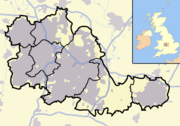List of Sites of Special Scientific Interest in the West Midlands facts for kids
There are twenty-three Sites of Special Scientific Interest (SSSIs) in the county of the West Midlands, England. As of 2008[update], of the twenty-three designated sites, eleven have been designated due to their biological interest, nine due to their geological interest and three for both. In England, the body responsible for designating SSSIs is Natural England, which chooses sites because of their flora, fauna, geological or physiographical features. Natural England took over the role of designating and managing SSSIs from English Nature in October 2006 when it was formed from the amalgamation of English Nature, parts of the Countryside Agency and the Rural Development Service. Natural England, like its predecessor, uses the 1974-1996 county system with each area being called an Area of Search. In the West Midlands case, the Area of Search matches the county boundary.
The West Midlands is the second largest conurbation, after Greater London, with a population of over 2.6 million inhabitants. Consisting of three large cities, Wolverhampton, Birmingham and Coventry, the county of the West Midlands is also one of the most densely populated areas in the United Kingdom. The result of this large human population is that every part of the area has been influenced by humans—often negatively—for example, the clearance of woodland to make room for agriculture. The West Midlands is an area of relatively high ground, ranging from around 500 to 1,000 feet (152–305 m) above sea level, forming the Birmingham Plateau. It is crossed by Britain's main north-south watershed between the basins of the Rivers Severn and Trent. The main habitat types in the area are heathland, woodland and grassland, all of which are found in both urban and rural contexts.
Between the West Midlands conurbation and Coventry is a stretch of green belt land roughly 15 miles (24 km) across known as the "Meriden Gap", which retains a strongly rural character, and is the site of a number of SSSIs including Berkswell Marsh. A smaller green belt is located between Birmingham, Walsall and West Bromwich which includes Sutton Park in Sutton Coldfield. Sutton Park, an SSSI and national nature reserve, has an area of 9.001 square kilometres (3.475 sq mi) making it one of the largest urban parks in Europe and the largest European park outside a capital city.
Sites
| Site name | Reason for designation | Area | Grid reference | Year in which notified | Map | ||
|---|---|---|---|---|---|---|---|
| Biological interest | Geological interest | Hectares | Acres | ||||
| Berkswell Marsh | 7.5 | 18.5 | 1991 | Map | |||
| Bickenhill Meadows | 7.2 | 17.8 | & | 1991 | Map | ||
| Brewin's Canal Section | 1.34 | 3.3 | 1990 | Map | |||
| Bromsgrove Road Cutting | 0.2 | 0.5 | 1990 | Map | |||
| Clayhanger | 23.8 | 58.8 | 1986 | Map | |||
| Daw End Railway Cutting | 8.1 | 20.9 | 1986 | Map | |||
| Doulton's Claypit | 3.3 | 8.2 | 1986 | Map | |||
| Edgbaston Pool | 15.6 | 38.5 | 1986 | Map | |||
| Fens Pools | 37.6 | 92.9 | 1989 | Map | |||
| Hay Head Quarry | 5.8 | 14.3 | 1986 | Map | |||
| Herald Way Marsh | 10.6 | 26.2 | 1988 | Map | |||
| Illey Pastures | 3.5 | 8.6 | 1989 | Map | |||
| Jockey Fields | 18.05 | 44.5 | 1994 | Map | |||
| Ketley Claypit | 13.7 | 33.9 | 1990 | Map | |||
| Monkspath Meadow | 1.2 | 3.0 | 1986 | Map | |||
| River Blythe | 102.2 | 252.5 | – | 1989 | Map | ||
| Stubbers Green Bog | 3.0 | 7.4 | 1986 | Map | |||
| Sutton Park | 866.1 | 2,140.1 | 1987 | Map | |||
| Swan Pool & The Swag | 5.7 | 14.0 | 1986 | Map | |||
| Tile Hill Wood | 29.4 | 72.6 | 1986 | Map | |||
| Turner's Hill | 1.5 | 3.7 | 1989 | Map | |||
| Webster's Claypit | 0.3 | 0.8 | 1986 | Map | |||
| Wren's Nest | 34.1 | 84.3 | 1990 | Map | |||


